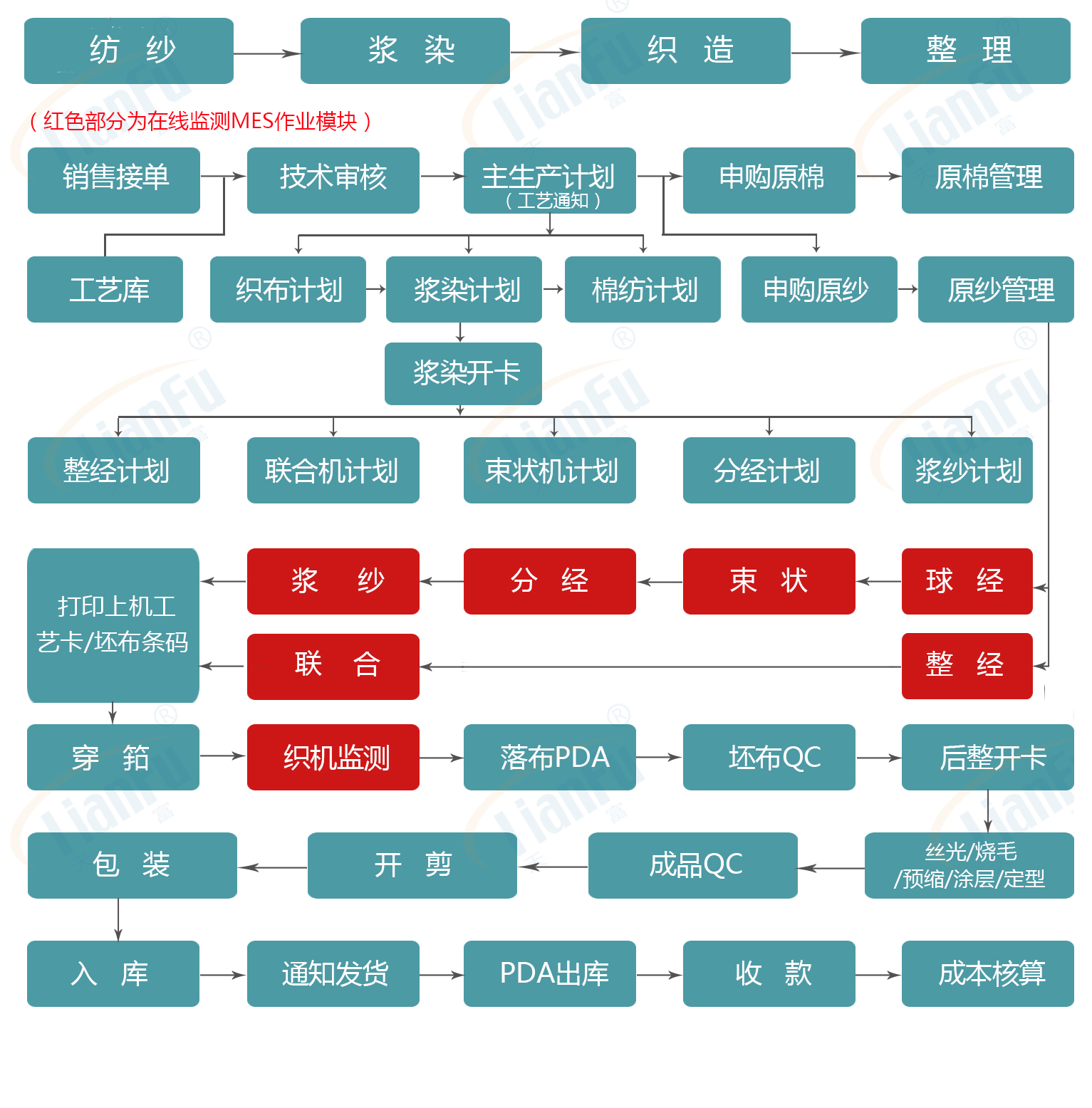


Workflow approval
Various types of purchases, orders, master plans, processes and notifications, test reports, invoices, and development approvals (PC and mobile).
Production on time and on schedule
According to the order quantity and variety loss, the delivery date of the finished product is accurately set in advance of the purchase/cotton spinning/slurry dyeing/weaving/post-production delivery. According to this, the workshop is decomposed into a machine plan and delivered to the site for on-time operation.。
Comprehensive process management
Spinning, dyeing, weaving, finishing (silk / pre-shrink / stereotype) process, bulk / sample process.
Quality control throughout
From the specification input of the order, the workshop, the laboratory to the inspection and inspection of the finished product, the whole process is online and controlled. All the quality problems clearly record the responsible person and the reason, and automatically generate the deduction and punishment.
Cost accounting
According to the raw materials and energy consumption of the order, combined with the fixed cost of dyeing materials, machine materials, and labor.
The ERP machine operation plan and process parameters are sent to the site to guide the workshop production;
Provide real-time data for ERP, master on-site changes, and quickly correct production plans;
Collect process parameters, shutdown causes, and energy consumption, providing traceability of the production process.
①Spinning single spindle inspection system
Debris detection, strong and weak boring, bad spindles, idle spindles, broken ends analysis with thousands of spindles, analysis of doffing breaks, and joint time analysis.
②Whole ball
Collect break rate, speed, tension, and time.
③Pulp dyeing machine monitoring system
Collect temperature, length, speed, pH, concentration, moisture regain, energy consumption, exceed a certain range of deviation, and send out an alarm signal.
④Loom monitoring system
Production and shutdown collection, monitoring of machine efficiency.
⑤Rear machine monitoring system
Automation is the premise of the realization of Industry 4.0, and intelligence is the management and inheritance of knowledge. It is connected with the ERP formula management to make the production process control intelligent, reduce people and increase efficiency, and stabilize quality.
①Unattended automatic cooking pulp system
Reduce precision by reducing the efficiency of people, increasing gelatinization time, cooking temperature, etc., reducing waste.
②Automatic delivery of dyeing auxiliaries
Solve the problem of inaccurate metering, different hand quality, waste of additives, and inability to track production problems. And cut labor, improve product consistency, while conducive to environmental protection, improve product competitiveness and so on.
③Automatic material conveying of indigo dye
Improve the automation level of the chemical process, eliminate the artificial ingredients error, improve the batching efficiency; reduce the consumption of additives, reduce the salt in the dye, improve the dye permeability and color fastness; improve the working environment and working conditions. The large screen monitors the flow pump to reduce quality accidents.
① The grey cloth inspection records the inspection result online; the result of the grey cloth inspection is fed back to the inspection inspection interface according to the finishing card number;
② To realize the whole process tracking of the grey cloth cloth number to the finished cloth volume number, the whole process from the grey cloth falling cloth to the grey cloth cloth number, to the grey cloth inspection, the finishing process, the finished product inspection and the cutting and winding packaging process, in order to facilitate the finished product. Tracking backtracking of each piece of cloth;
③ Implemented online shop fabric specimen inspection system, review, sampling, each piece of cloth defect collected online, fabric length and other information;
④Inspect the previous process to fabricate the points, and make a corresponding score according to the four-point scoring standard, and cut according to the condition of the cloth surface.
